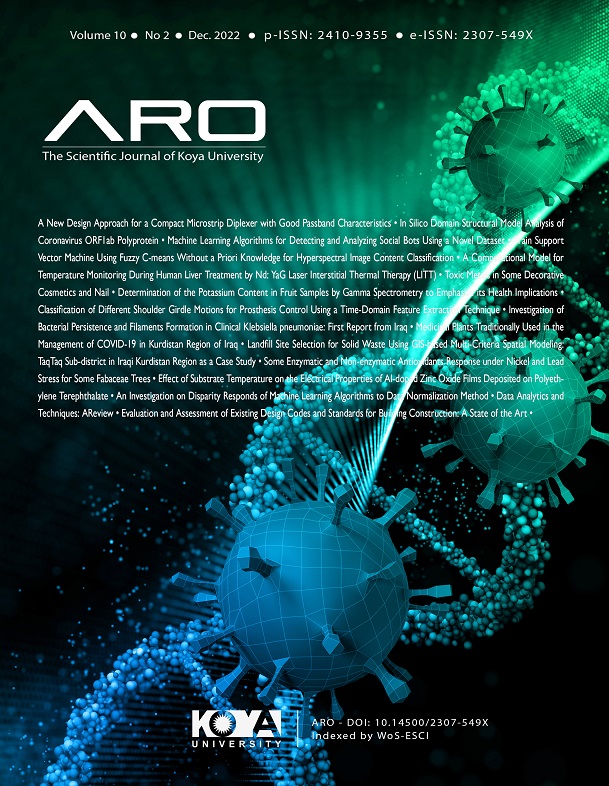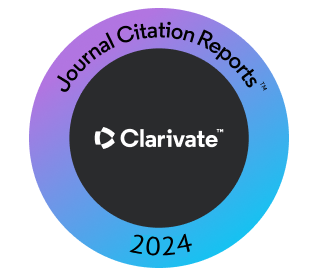In Silico Domain Structural Model Analysis of Coronavirus ORF1ab Polyprotein
DOI:
https://doi.org/10.14500/aro.10829Keywords:
Coronavirus, Ligand, Modeling, ORF1abAbstract
The world today is battling with a coronavirus infection that is considered a global pandemic. Coronavirus infection is mainly attribute to the varying technique of the replication and release of different genomic components of the virus. The present study aims to establish the physical and chemical features, as well as the basic structural and functional properties of Coronavirus ORF1ab domain. A molecular approach was adopt in this study using the Swiss Model and Phyre2 server whereas the prediction of the active ligand binding sites was done using Phyre2. The analysis of the structure of the protein showed that it has good structural and heat stability, as well as better hydrophilic features and acidic in nature. Based on the Homology modeling, only two binding active sites were noted with catalytic function being mediated by Zn2+ as the metallic heterogeneous ligand for binding sites prediction. The proteins mostly exhibited helical secondary configurations. This study can help in predicting and understanding the role of this domain protein in active coronavirus infection.
Downloads
References
Gasteiger, J. and Walker, M., 2005. The Proteomics Protocols Handbook. Springer, Berlin, p.571.
Geourjon, C. and Deleage, G.C., 1995. SOPMA: Significant improvements in protein secondary structure prediction by consensus prediction from multiple alignments. Computer Applied Bioscience, 681(11), pp.681-684.
Gil, S.C. and Von Hippel, P.H., 1989. Calculation of protein extinction coefficients from amino acid sequence data. Analytical Biochemistry, 182(2), pp.319-326.
Hamp, T., Kassner, R., Seemayer, S., Vicedo, E., Schaefer, C., Achten, D., Auer, F., Boehm, A., Braun, T., Hecht, M., Heron, M., Hönigschmid, P., Hopf, T.A., Kaufmann, S.A., Kiening, M., Krompass, D., Landerer, C., Mahlich, Y., Roos, M. and Rost, B., 2013. Homology-based inference sets the bar high for protein function prediction. BMC Journal Bioinformatics, 14(7), pp.502-511.
Kelly, L.A, Mezulis, S., Yates, C.M., Wass, M.N. and Sternberg, M.J., 2015. The Phyre2 web portal for protein modeling, prediction and analysis. Nature Protocols, 10(6), p.845.
Kyte, J. and Doolottle, R.F., 1982. Asimple method for displaying the hydropathic character of a protein. Journal of Molecular Biology, 157(1), pp.105-132.
Li, S., Yuan, L., Dai, G., Chen, R.A., Liu, D.X. and Fung, T.S., 2020. Regulation of the ER stress response by the Ion channel activity of the infectious bronchitis coronavirus envelope protein modulates virion release, apoptosis, viral fitness, and pathogenesis. Frontiers in Microbiology, 10, p.3022.
McBride, R. and Fielding, B.C., 2012. The role of severe acute respiratory syndrome (SARS) coronavirus accessory proteins in virus pathogenesis. Viruses, 4(11), pp.2902-2923.
Ofran, Y. and Rost, B., 2007. ISIS: Interaction sites identified from sequence. Bioinformatics Journal, 23(2), pp.e13-e16.
Paraskevis, D., Kostaki, E.G., Magiorkinis, G., Panayiotakopoulos, G., Sourvinos, G. and Tsiodras, S., 2020. Full-genome evolutionary analysis of the novel corona virus (2019-nCoV) rejects the hypothesis of emergence as a result of a recent recombination event. Infection Genetics and Evolution, 79, pp.104-212.
Raik, G. and Luis, S., 2010. Strategies for protein synthetic biology. Nucleic Acids Research Journal, 38(8), pp.2663-2675.
Remmert, M., Andreas, B., Andreas, H. and Johannes, S., 2012. HHblits: Lightning-fast iterative protein sequence searching by HMM-HMM alignment. Nature Methods, 9(2), pp.173-178.
Rost, B., Guy, Y. and Liu, J., 2004. The predicProtein server. Nucleic Acid Research Journal, 32(2), pp.321-326.
Rothe, C., Schunk, M., Sothmann, P., Bretzel, G., Froeschl, G., Wallrauch, C., Zimmer, T., Thiel, V., Janke, C., Guggemos, W., Seilmaier, M., Drosten, C., Vollmar, P., Zwirglmaier, K., Zange, S., Wölfel, R. and Hoelscher, M., 2020.
Transmission of 2019-nCoV infection from an asymptomatic contact in Germany. New England Journal of Medicine, 382(10), pp.970-971.
Schaecher, S.R. and Pekosz, A., 2010. Molecular Biology of the SARSCoronavirus. Springer, Berlin, pp.153-166.
To, K.K.W., Tsang, O.T., Yip, C.C., Chan, K.H., Wu, T.C., Chan, J.M., Leung, W.S., Chik, T.S., Choi, C.Y., Kandamby, D.H., Lung, D.C., Tam, A.R., Poon, R.W., Fung, A.Y., Hung, I.F., Cheng, V.C., Chan, J.F. and Yuen, K.Y., 2020. Consistent detection of 2019 novel coronavirus in saliva. Clinical Infectious Diseases, 71(15), pp.841-843.
Wu, A., Peng, Y., Huang, B., Ding, X., Wang, X., Niu, P., Meng, J., Zhu, Z., Zhang, Z., Wang, J., Sheng, J., Quan, L., Xia, Z., Tan, W., Cheng, G. and Jiang, T., 2020. Genome composition and divergence of the novel coronavirus (2019- nCoV) originating in China. Cell Host and Microbe, 27(3), pp.325-328.
Wu, F., Zhao, S., Yu, B., Chen, Y., Hu, Y., Tao, Z.W., Tian, J.H., Pei, Y.Y., Yuan, M.L., Zhang, Y.L., Dai, F.H., Liu, Y., Wang, Q.M., Zheng, J.J., Xu, L., Holmes, E.C. and Zhang, Y.Z., 2020. Anew coronavirus associated with human respiratory disease in China. Nature, 579(7798), pp.265-269.
Zhu, N., Zhang, D., Wang, W., Li, X., Yang, B., Song, J., Zhao, X., Huang, B., Shi, W., Lu, R., Niu, P., Zhan, F., Ma, X., Wang, D., Xu, W., Wu, G., Gao, G.F. and Tan, W., 2020. Anovel coronavirus from patients with pneumonia in China, 2019. New England Journal of Medicine, 382(8), pp.727-733.
Downloads
Published
How to Cite
Issue
Section
License
Authors who choose to publish their work with Aro agree to the following terms:
-
Authors retain the copyright to their work and grant the journal the right of first publication. The work is simultaneously licensed under a Creative Commons Attribution License [CC BY-NC-SA 4.0]. This license allows others to share the work with an acknowledgement of the work's authorship and initial publication in this journal.
-
Authors have the freedom to enter into separate agreements for the non-exclusive distribution of the journal's published version of the work. This includes options such as posting it to an institutional repository or publishing it in a book, as long as proper acknowledgement is given to its initial publication in this journal.
-
Authors are encouraged to share and post their work online, including in institutional repositories or on their personal websites, both prior to and during the submission process. This practice can lead to productive exchanges and increase the visibility and citation of the published work.
By agreeing to these terms, authors acknowledge the importance of open access and the benefits it brings to the scholarly community.
Accepted 2022-07-28
Published 2022-08-25
















 ARO Journal is a scientific, peer-reviewed, periodical, and diamond OAJ that has no APC or ASC.
ARO Journal is a scientific, peer-reviewed, periodical, and diamond OAJ that has no APC or ASC.